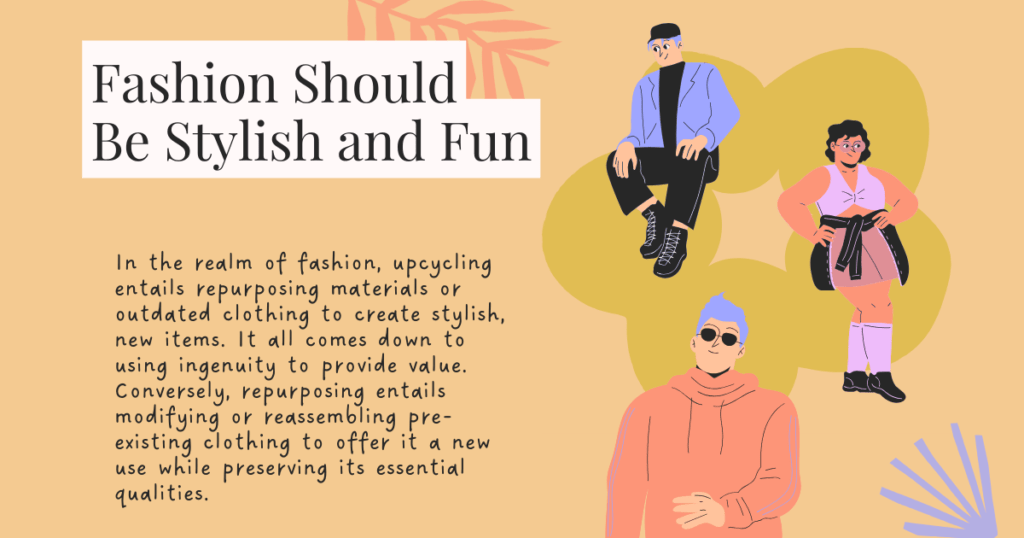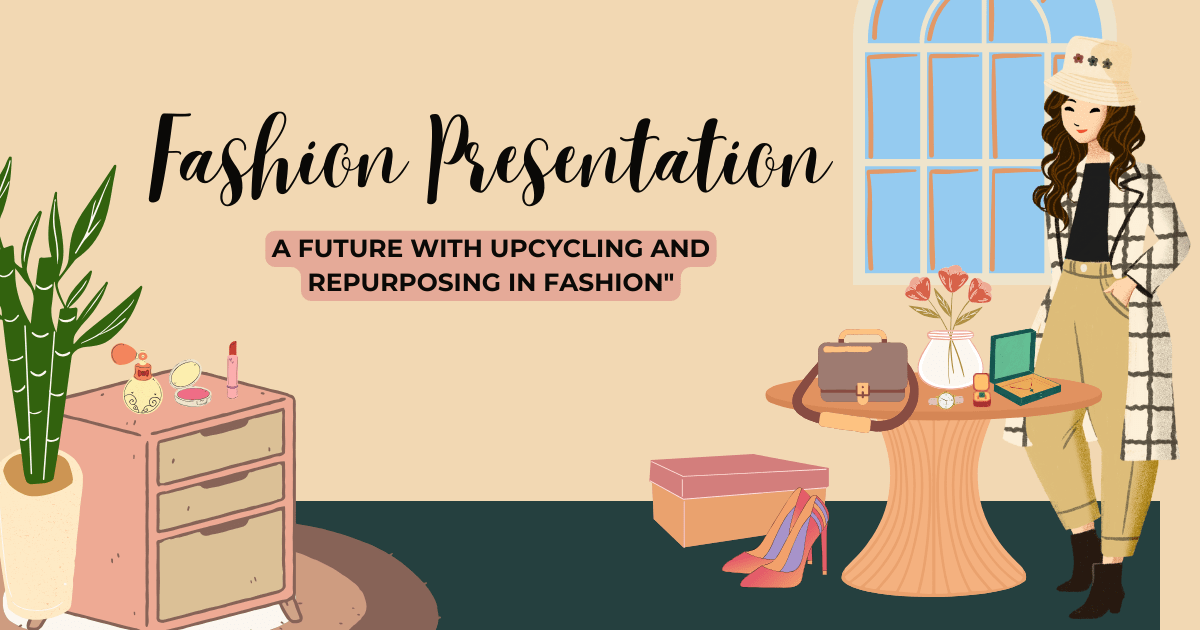Imagine a future in which the stylish jacket you own conveys a captivating tale of metamorphosis in addition to looking great. That is the fashion industry’s secret to upcycling and repurposing in fashion. But let’s dissect it a little:
Understand the Upcycling and Repurposing in fashion
Do you remember the thrill of discovering a hidden gem among your clutter? In the realm of fashion, upcycling entails repurposing materials or outdated clothing to create stylish, new items. It all comes down to using ingenuity to provide value. Conversely, repurposing entails modifying or reassembling pre-existing clothing to offer it a new use while preserving its essential qualities.
The Need for Change in the Fashion Industry
Although the fashion industry is glamourous, it is also one of the biggest pollutants. Water waste, chemical pollution, overflowing landfills—the industry has a significant environmental impact that has to alter.
Historical Context and Evolution
Historically, upcycling was a necessity. Remember how your grandparents patched clothes or turned old drapes into a new dress? With time, though, upcycling lost its charm under the shadow of fast fashion. Luckily, it’s making a cool comeback, blending tradition with innovation.

2. The Environmental Impact of Upcycling in Fashion
Putting the planet first—here’s what upcycling does:
Reducing Waste
This one’s straight-up impressive. By reusing materials, upcycling significantly cuts down the amount of waste destined for landfills. It’s like telling the Earth, “Don’t worry, we’ve got your back.”
Conservation of Resources
When we upcycle, we also save big on resources. Imagine saving gallons of water and heaps of energy that would otherwise be spent in producing something brand new. Yep, upcycling does that.
Carbon Footprint Analysis
Let’s talk facts. Traditional fashion production has a hefty carbon footprint. Upcycling, meanwhile, slashes these emissions by using existing materials instead of producing new ones from scratch.
3. Economic Benefits and Challenges
Upcycling isn’t just good for Earth—it makes cents too:
Cost-Effectiveness of Upcycling
Got an old tee lying around? Think of upcycling as a DIY project that saves you shopping money. For designers, it’s a way to sidestep some raw material costs.
Scalability in the Fashion Industry
Starting small is key, but don’t be fooled—upcycling has the potential to grow bigger. What begins in a small studio can influence entire fashion lines, encouraging big brands to rethink how they source materials.
Challenges Facing Upcycling
It’s not all smooth sailing. Finding enough quality materials to reuse can be tough, not to mention the extra labor it takes to create something truly stunning from old fabrics. And let’s not forget, convincing customers to hop on this trend is its own hurdle.
4. Case Studies: Successful Upcycling Brands
Check out these champs who are rocking the upcycling trend:
Innovative Design Examples
Brands like Patagonia and Reformation are turning unwanted fabrics into must-have outfits, proving that style doesn’t have to be sacrificed for sustainability.
The Design Process
These brands get down to the nitty-gritty, sorting through mountains of old clothes and textiles to find those gems that can be transformed into something beautiful.
Market Reception and Consumer Feedback
Customers are loving the stories behind their upcycled clothes. It’s fashion with a conscience, and who wouldn’t want to brag about that?
5. The Role of Technology and Innovation
Let tech take the sustainability wheel:
Technological Advancements in Upcycling
From nifty software for designing to hardcore machines breaking down materials, technology is a game changer in how we upcycle.
Entrepreneurial Approaches to Repurposing
Startups are getting creative with the repurposing game, crafting everything from luxury accessories to everyday essentials out of discarded materials.
Collaborations and Partnerships
Think of it as a team-up for Mother Earth. Brands, tech companies, and environmental activists joining forces could significantly magnify the impact of upcycling.
6. Future Directions and Predictions
Curious about the future? Here’s the scoop:
Trends to Watch in Upcycling
Eco-friendly is becoming the new black. Expect to see more organic materials and innovative, sustainable techniques taking center stage in fashion spreads.
Regulatory and Policy Considerations
Governments stepping in could be a game-changer by setting sustainability standards and offering incentives for greener practices in fashion.
Educational Initiatives and Consumer Awareness
Knowledge is power. More educational programs and campaigns could cultivate an enlightened consumer base that prioritizes sustainability in their fashion choices.

Conclusion: The Path Forward for Sustainable Fashion
So, what have we learned today? Upcycling and repurposing aren’t just about making fashion sustainable; they’re about creating a culture that values resourcefulness and innovation. Let’s keep this movement stylish, sustainable, and forward-thinking.
What exactly is upcycling in the context of fashion, and how does it differ from recycling? Upcycling in fashion involves taking discarded or unused materials and transforming them into new garments or accessories with higher value or quality. Unlike recycling, which breaks down materials to create new ones, upcycling retains the original material’s integrity, often resulting in unique and creatively designed pieces.
How can fashion brands incorporate upcycling and repurposing into their design processes and production methods? Fashion brands can integrate upcycling and repurposing by sourcing surplus fabrics or materials, collaborating with artisans or local communities skilled in repurposing techniques, and designing modular or reversible garments that allow for versatility and extended use.
What are some examples of successful upcycling initiatives or brands in the fashion industry? Examples include brands like Patagonia, which upcycles materials like plastic bottles into clothing, and Eileen Fisher, known for its Renew program that transforms old garments into new ones. Additionally, initiatives like The R Collective and Fashion for Good showcase innovative approaches to upcycling in fashion.
What are the environmental benefits of upcycling and repurposing materials in fashion, compared to traditional manufacturing methods? Upcycling reduces the need for virgin materials, minimizes waste sent to landfills, conserves energy and resources required for production, and lowers carbon emissions associated with manufacturing, contributing to a more sustainable fashion industry.
How can consumers support the upcycling movement and make more sustainable fashion choices in their everyday lives? Consumers can support upcycling by choosing to purchase from brands that prioritize sustainable practices, buying second-hand or vintage clothing, participating in clothing swaps or rental programs, and educating themselves about the environmental impacts of their fashion choices.
What are the challenges and obstacles faced by fashion designers and brands when transitioning to upcycled materials and sustainable practices? Challenges include sourcing consistent and high-quality upcycled materials, maintaining affordability and scalability, educating consumers about the value of upcycled products, and navigating complex supply chains to ensure ethical and transparent production processes.


